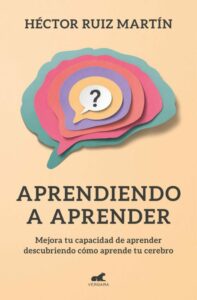26 March 2021
Evidence of how learning takes place helps teachers to guide effective learning
By Jordi Viladrosa i Clua
Héctor Ruiz Martín is the International Science Teaching Foundation director and an expert in the cognitive psychology of memory and learning, disciplines on which part of his research focuses. He is also the author of ¿Cómo aprendemos? Una aproximación científica al aprendizaje de y a la enseñanza (Editorial Escalón), and Conoce tu cerebro para aprender a aprender (ISTF).

The trap of an exam-oriented curriculum and quantitative academic results hinders the effective learning of strategies linked to scientific evidence about how our brains learn. Passing exams and giving them a high value in assessing a subject or course sends a message to students: they need to use practical study skills to demonstrate what they have learned in the short term. This is a kind of self-deception since, in the medium and long term, these methods are generally relatively ineffective without the cognitive effort involved in evocation or reasoning and learning lapses in a relatively short time. In this book, Héctor Ruiz sets out a global objective for teachers: to guide their students’ learning, do it effectively, and validate scientific evidence. A work, then, to learn how to learn.
Effective learning strategies, not all of which are innate, are predictors of academic success based on scientific research from neuroscience and cognitive science on how the brain works. In his eight chapters, the author describes how the brain learns, concentrates, thinks, remembers, forgets, diversifies, motivates and controls itself to learn. No less attractive is the appendix where Ruiz briefly describes some learning strategies that are not very effective but often used by our students.

In this book, Héctor Ruiz sets out a global objective for teachers: to guide their students’ learning, do it effectively, and validate scientific evidence
From chapter two onwards, there are some practical recommendations at the end of each chapter based on a key idea as a summary, preceded by an elaborate compilation of arguments and examples. Turning this work into a practical, very structured manual and easy to consult for anyone who wants to know how our brain learns based on the available scientific research.
The following is a summary of some aspects of the author’s contributions we consider interesting.
The first chapter explores the basic models that science has used to explain how memory works and learning occurs. We were pleased to see that Héctor Ruiz does not ignore this human capacity which is an aspect with many defenders and detractors. And, related to it, the relevance of prior knowledge for the solid acquisition of new learning.
Chapter two highlights the role of distractions, the extraneous cognitive load (p. 47), during learning tasks and, of course, their relation to attention and its limitations. The key idea of this chapter is that to optimise study time, we need to focus our cognitive resources on the object of learning and manage its limitations (p. 58). Practical recommendations are as follows:
- Remove possible distractions from the study environment.
- Establish a time routine for study sessions.
- Plan the objectives of each study session.
Memory is shown as a great ally of reasoning in chapter three. Remembering is a much simpler, quicker and more effective way of solving a problem (p. 69). The author points out that learning needs to be active, in the sense that it is a mental activity that involves learning by thinking. If one does not seek to make sense of what one is studying, no learning strategy will be effective enough. Hence the importance of prioritising elaboration over simple repetition. The key idea is that the best way to anchor what we are studying in our memory is to make sense of it and relate it explicitly to other things we already know (p. 84). The practical recommendations of this chapter are:
- Explain what you are learning to yourself
- Question yourself periodically.
- Make connections with what you know.
- Try different approaches.
- Use visual resources.
- Use mnemonic strategies when appropriate.
Chapter four provides us with one of the essential keys to learning: to affirm that we have learned something, we must be able to extract it from our memory (p. 93). Of the three learning processes that the author mentions in this work: encoding – storing – recalling, everyday practice usually emphasises the third one, which, in fact, and according to scientific evidence, reminds us that it is much more effective to recall what we have learned than to study it again, despite the cognitive cost that this usually entails. The key idea is that to strengthen learning most effectively, we need to review what we have learned by trying to retrieve it from our memory and not just by re-studying it (p. 109). The recommendations offered by the author are:
- When you review, do not reread; recall.
- Self-assess.
- Seek feedback after evoking.
- Really try before consulting the answer.
- Teach others.
The role of forgetting and emotions in learning is the target in the fifth chapter. One of the most common techniques for dealing with forgetting has always been repetition. Still, for it to be more effective, the author argues that there needs to be a time between studying and reviewing or practising what has been learned. The intellectual work technique derived is that when the practice of evocation is combined with spaced practise, we achieve better results. If besides, the initial study is carried out by elaboration, it cannot be better (p. 125). This chapter’s fundamental idea is that to learn more effectively, it is important to review what has been studied and not to concentrate study and review in the same session, but to space it out over time (p. 133). Practical recommendations include:
- Organise the subject matter to be studied and establish a work schedule.
- Interlace your study sessions.
- Do not over-study.
- Get the necessary amount of sleep.
- Don’t leave everything to the last day.
The challenge of using knowledge in a different context from the one it was acquired, the so-called transfer of learning, is the crucial point of Chapter six. In the author’s words: Making use of several examples to learn a concept or a procedure contributes significantly to our ability to transfer it because it increases the number of contexts that will activate it in our memory (p. 154). The author recommends:
- Study from varied examples.
- Interweave the topics and procedures under study.
- Do not shy away from other learning environments.
Chapter seven’s starting statement is motivation is the key to learning (p. 157). Motivation requires a motive, a goal. Depending on each student’s goals, certain behaviours will take place: some will be performance-related (grades), and others learning-related. To this situation, we need to add confidence to achieve the motivation above, linked to the psychological construct called self-efficacy (p. 163). Another element to consider is the role of fixed mind-set and growth mind-set towards learning and their impact on academic performance. The key idea is the need to understand the factors that modulate one’s own motivation to intervene (p. 181). Practice recommendations are:
- Reconsider what you attribute your successes or failures in the learning process.
- Relativise these mistakes and failures.
- Assess your sense of self-efficacy and reflect on it.
- Try new ways of approaching learning.
Héctor Ruiz dedicates the last chapter to the ability to self-regulate learning, self-control, whether we are referring to cognitive or emotional control. Regulating emotions is very important for students for two reasons: they influence performance and play an important role in the motivation factor. As a key idea, we have to plan the study, select the most appropriate strategies, evaluate the results; and do so in the emotional area involves self-regulation of learning. Practical recommendations are:
- Use effective study strategies.
- Use cognitive reappraisal to keep your self-efficacy strong.
- Avoid distractions during study and exams.
- Don’t leave all studying to the last minute.
- Relax before the exam.
This book is a more informative version of the technical manual How do we learn? (2020) by the same author. The aim is to ensure that learning lasts over time and that it is transferable and serves as a basis for the acquisition of new learning throughout life.
Relacionado con: Article, Expert educació, Llibres educació, Ressenyes
You might also









Leave A Comment